Comprehensive Management Accounting Report: Tesco's Performance
VerifiedAdded on 2023/01/13
|17
|4685
|55
Report
AI Summary
This report provides a comprehensive analysis of management accounting principles as applied to Tesco. It delves into the core concepts of management accounting, outlining its objectives and distinguishing it from financial accounting. The report examines various management accounting systems utilized by Tesco, including inventory management, job costing, cost accounting, activity-based costing, and price optimization. It further explores management accounting reporting methods such as budget reports, performance reports, and cost accounting reports, detailing their significance in evaluating and enhancing company performance. The report also discusses cost calculation techniques, focusing on marginal costing and its benefits. Finally, it addresses the importance of adapting management accounting methods to address financial challenges within an organization, using Tesco as a case study. The report concludes with a summary of key findings and recommendations for effective financial management.
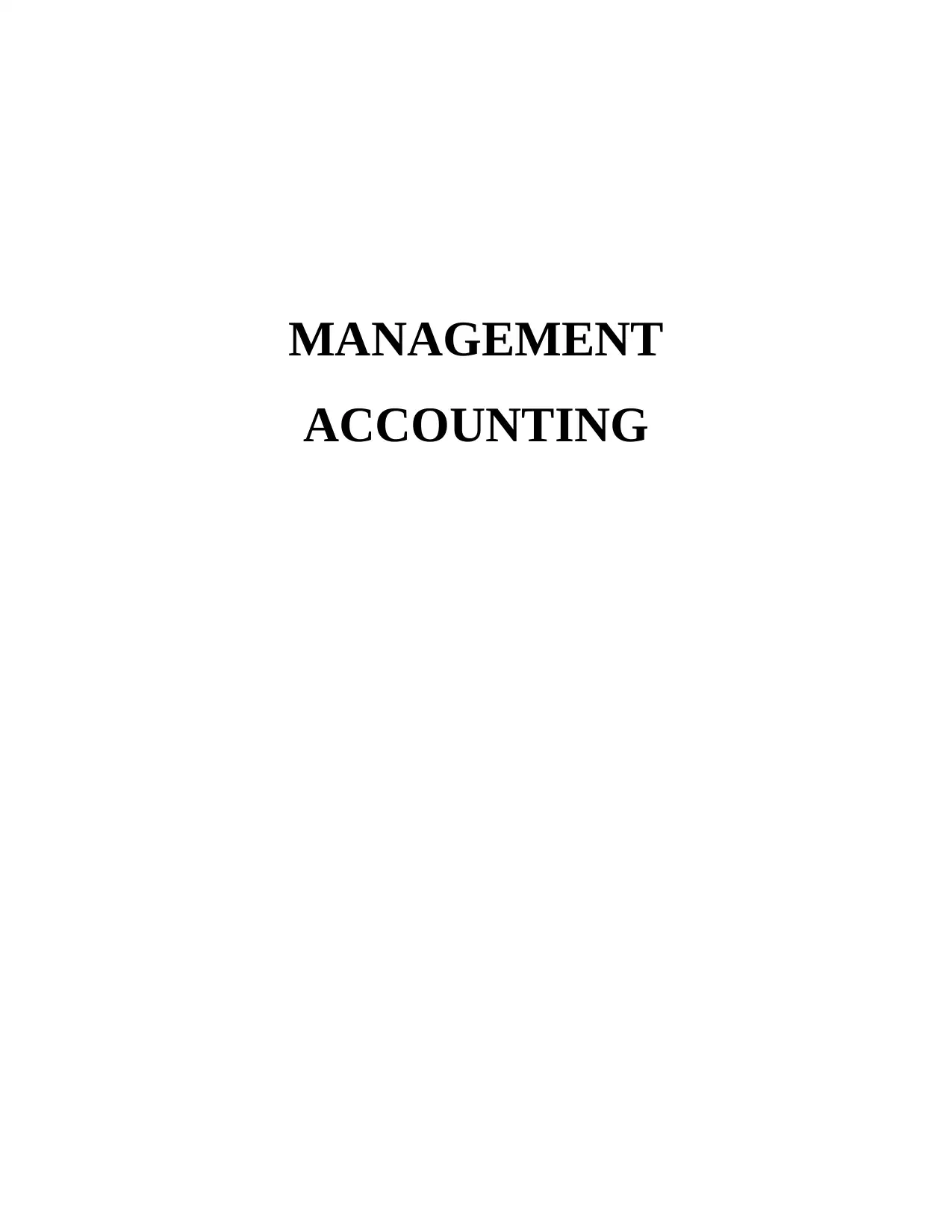
MANAGEMENT
ACCOUNTING
ACCOUNTING
Paraphrase This Document
Need a fresh take? Get an instant paraphrase of this document with our AI Paraphraser
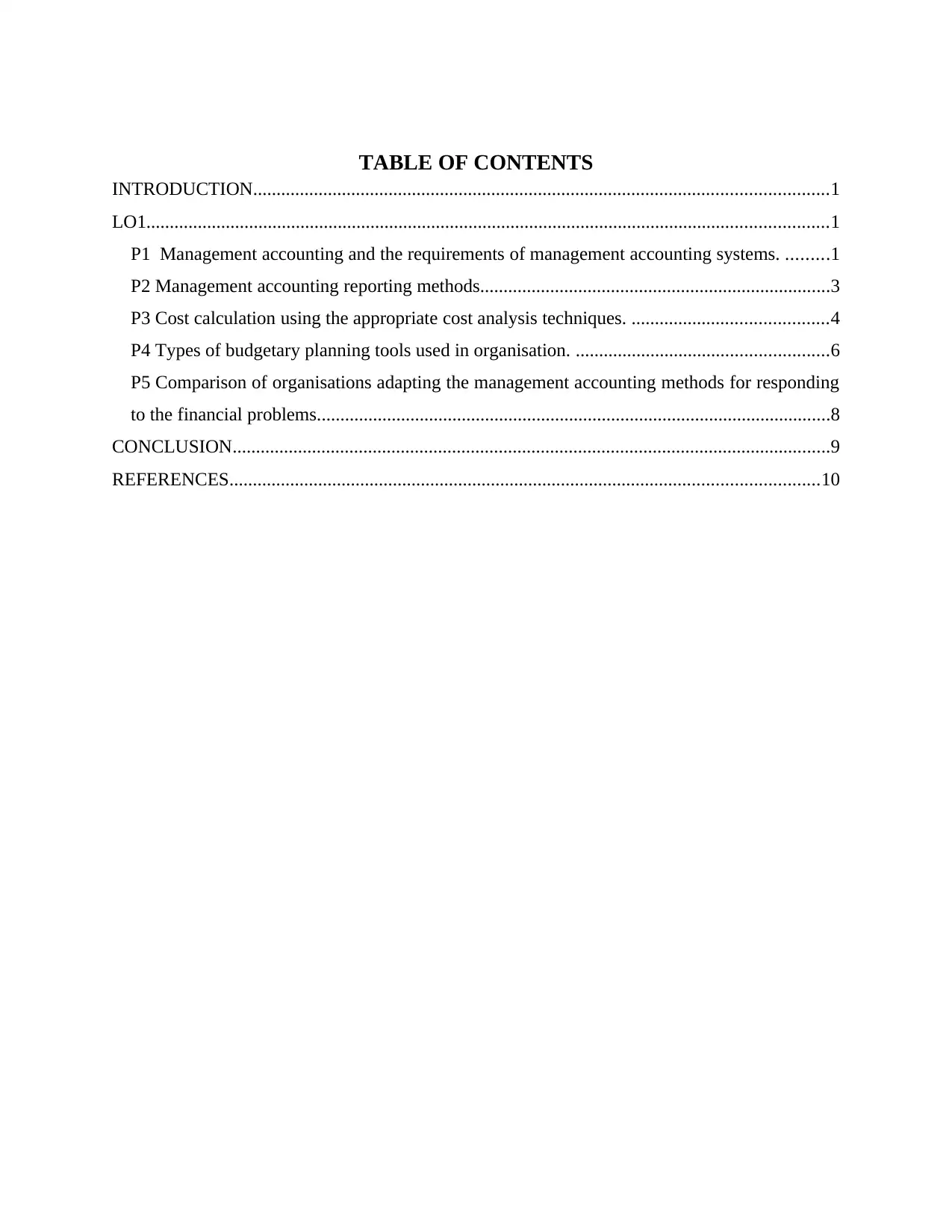
TABLE OF CONTENTS
INTRODUCTION...........................................................................................................................1
LO1..................................................................................................................................................1
P1 Management accounting and the requirements of management accounting systems. .........1
P2 Management accounting reporting methods...........................................................................3
P3 Cost calculation using the appropriate cost analysis techniques. ..........................................4
P4 Types of budgetary planning tools used in organisation. ......................................................6
P5 Comparison of organisations adapting the management accounting methods for responding
to the financial problems..............................................................................................................8
CONCLUSION................................................................................................................................9
REFERENCES..............................................................................................................................10
INTRODUCTION...........................................................................................................................1
LO1..................................................................................................................................................1
P1 Management accounting and the requirements of management accounting systems. .........1
P2 Management accounting reporting methods...........................................................................3
P3 Cost calculation using the appropriate cost analysis techniques. ..........................................4
P4 Types of budgetary planning tools used in organisation. ......................................................6
P5 Comparison of organisations adapting the management accounting methods for responding
to the financial problems..............................................................................................................8
CONCLUSION................................................................................................................................9
REFERENCES..............................................................................................................................10
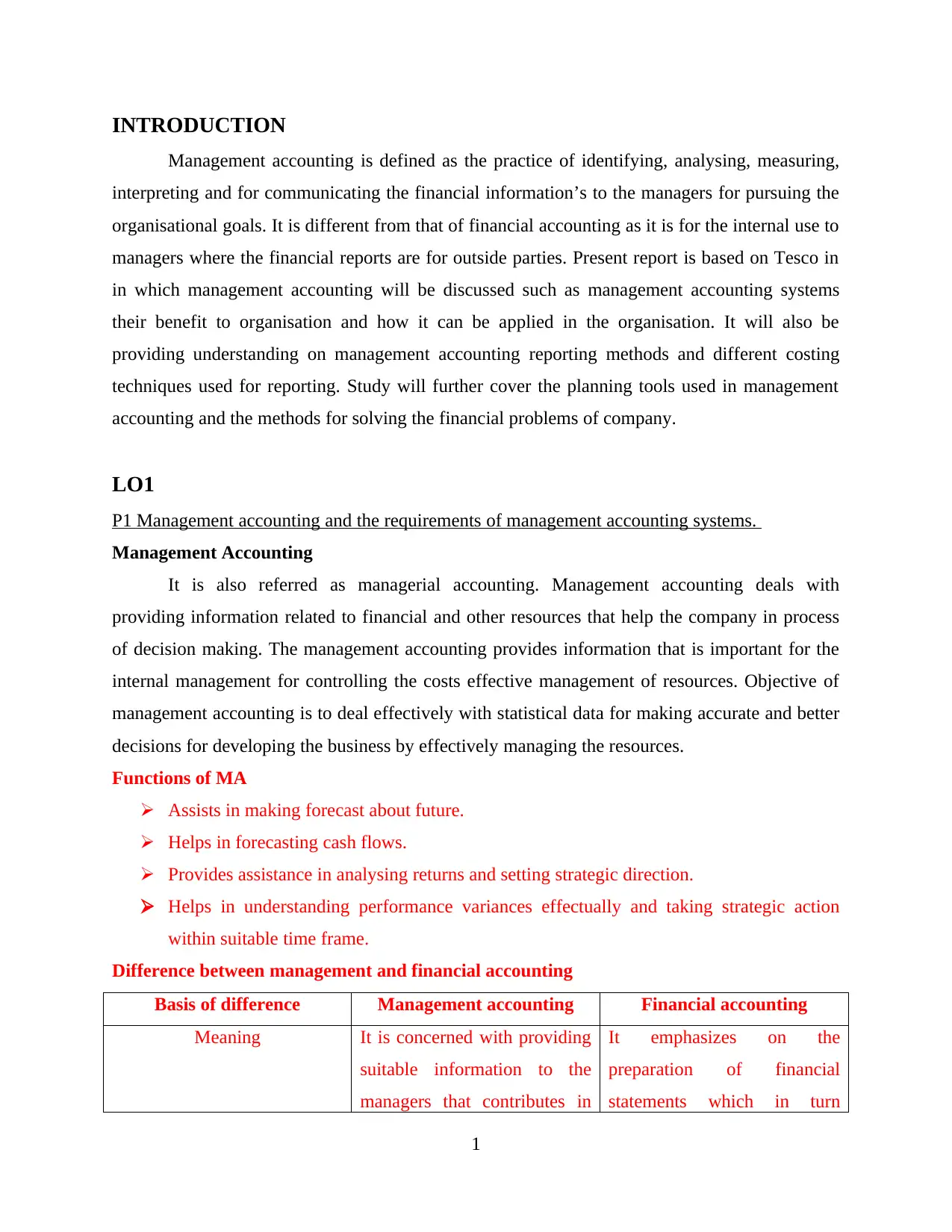
INTRODUCTION
Management accounting is defined as the practice of identifying, analysing, measuring,
interpreting and for communicating the financial information’s to the managers for pursuing the
organisational goals. It is different from that of financial accounting as it is for the internal use to
managers where the financial reports are for outside parties. Present report is based on Tesco in
in which management accounting will be discussed such as management accounting systems
their benefit to organisation and how it can be applied in the organisation. It will also be
providing understanding on management accounting reporting methods and different costing
techniques used for reporting. Study will further cover the planning tools used in management
accounting and the methods for solving the financial problems of company.
LO1
P1 Management accounting and the requirements of management accounting systems.
Management Accounting
It is also referred as managerial accounting. Management accounting deals with
providing information related to financial and other resources that help the company in process
of decision making. The management accounting provides information that is important for the
internal management for controlling the costs effective management of resources. Objective of
management accounting is to deal effectively with statistical data for making accurate and better
decisions for developing the business by effectively managing the resources.
Functions of MA
Assists in making forecast about future.
Helps in forecasting cash flows.
Provides assistance in analysing returns and setting strategic direction.
Helps in understanding performance variances effectually and taking strategic action
within suitable time frame.
Difference between management and financial accounting
Basis of difference Management accounting Financial accounting
Meaning It is concerned with providing
suitable information to the
managers that contributes in
It emphasizes on the
preparation of financial
statements which in turn
1
Management accounting is defined as the practice of identifying, analysing, measuring,
interpreting and for communicating the financial information’s to the managers for pursuing the
organisational goals. It is different from that of financial accounting as it is for the internal use to
managers where the financial reports are for outside parties. Present report is based on Tesco in
in which management accounting will be discussed such as management accounting systems
their benefit to organisation and how it can be applied in the organisation. It will also be
providing understanding on management accounting reporting methods and different costing
techniques used for reporting. Study will further cover the planning tools used in management
accounting and the methods for solving the financial problems of company.
LO1
P1 Management accounting and the requirements of management accounting systems.
Management Accounting
It is also referred as managerial accounting. Management accounting deals with
providing information related to financial and other resources that help the company in process
of decision making. The management accounting provides information that is important for the
internal management for controlling the costs effective management of resources. Objective of
management accounting is to deal effectively with statistical data for making accurate and better
decisions for developing the business by effectively managing the resources.
Functions of MA
Assists in making forecast about future.
Helps in forecasting cash flows.
Provides assistance in analysing returns and setting strategic direction.
Helps in understanding performance variances effectually and taking strategic action
within suitable time frame.
Difference between management and financial accounting
Basis of difference Management accounting Financial accounting
Meaning It is concerned with providing
suitable information to the
managers that contributes in
It emphasizes on the
preparation of financial
statements which in turn
1
⊘ This is a preview!⊘
Do you want full access?
Subscribe today to unlock all pages.

Trusted by 1+ million students worldwide
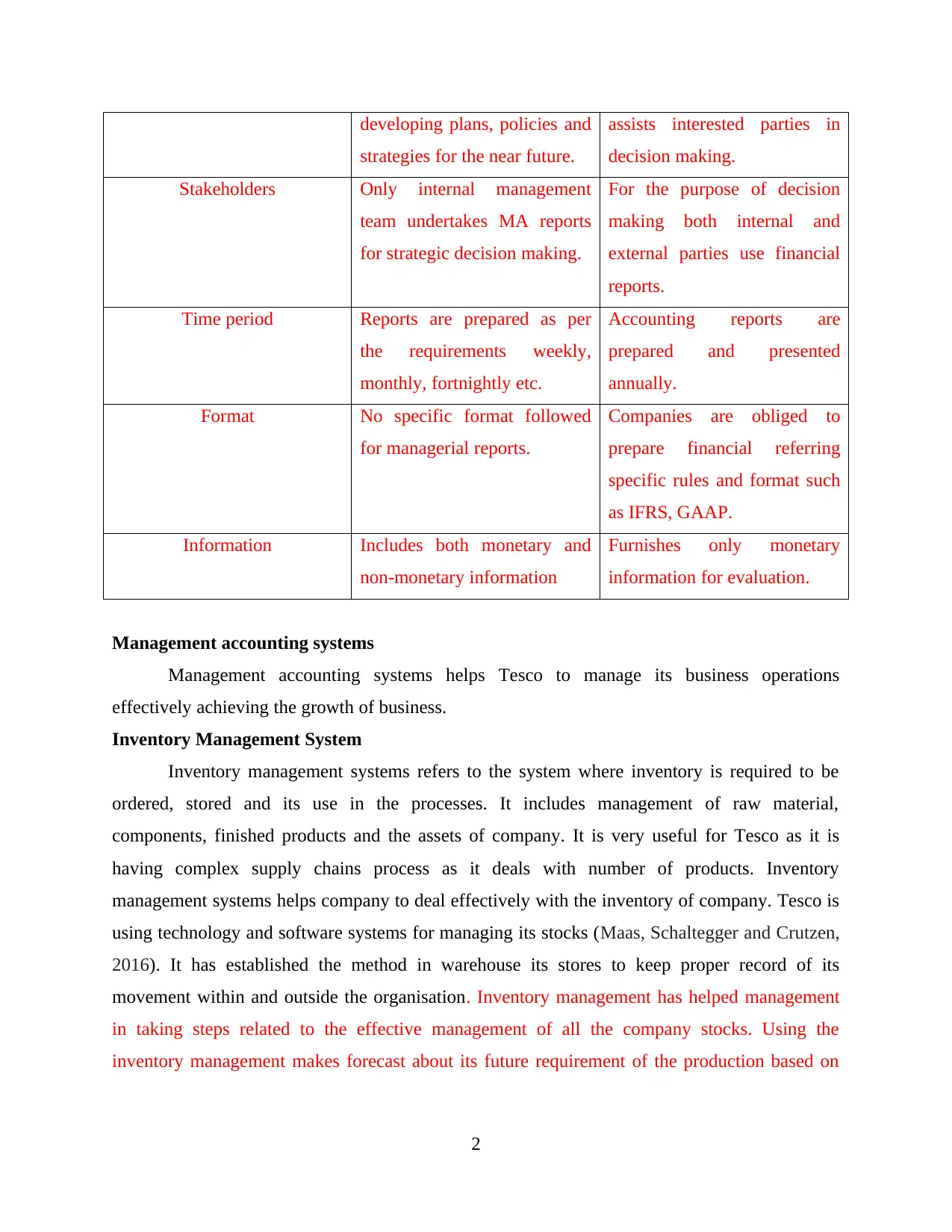
developing plans, policies and
strategies for the near future.
assists interested parties in
decision making.
Stakeholders Only internal management
team undertakes MA reports
for strategic decision making.
For the purpose of decision
making both internal and
external parties use financial
reports.
Time period Reports are prepared as per
the requirements weekly,
monthly, fortnightly etc.
Accounting reports are
prepared and presented
annually.
Format No specific format followed
for managerial reports.
Companies are obliged to
prepare financial referring
specific rules and format such
as IFRS, GAAP.
Information Includes both monetary and
non-monetary information
Furnishes only monetary
information for evaluation.
Management accounting systems
Management accounting systems helps Tesco to manage its business operations
effectively achieving the growth of business.
Inventory Management System
Inventory management systems refers to the system where inventory is required to be
ordered, stored and its use in the processes. It includes management of raw material,
components, finished products and the assets of company. It is very useful for Tesco as it is
having complex supply chains process as it deals with number of products. Inventory
management systems helps company to deal effectively with the inventory of company. Tesco is
using technology and software systems for managing its stocks (Maas, Schaltegger and Crutzen,
2016). It has established the method in warehouse its stores to keep proper record of its
movement within and outside the organisation. Inventory management has helped management
in taking steps related to the effective management of all the company stocks. Using the
inventory management makes forecast about its future requirement of the production based on
2
strategies for the near future.
assists interested parties in
decision making.
Stakeholders Only internal management
team undertakes MA reports
for strategic decision making.
For the purpose of decision
making both internal and
external parties use financial
reports.
Time period Reports are prepared as per
the requirements weekly,
monthly, fortnightly etc.
Accounting reports are
prepared and presented
annually.
Format No specific format followed
for managerial reports.
Companies are obliged to
prepare financial referring
specific rules and format such
as IFRS, GAAP.
Information Includes both monetary and
non-monetary information
Furnishes only monetary
information for evaluation.
Management accounting systems
Management accounting systems helps Tesco to manage its business operations
effectively achieving the growth of business.
Inventory Management System
Inventory management systems refers to the system where inventory is required to be
ordered, stored and its use in the processes. It includes management of raw material,
components, finished products and the assets of company. It is very useful for Tesco as it is
having complex supply chains process as it deals with number of products. Inventory
management systems helps company to deal effectively with the inventory of company. Tesco is
using technology and software systems for managing its stocks (Maas, Schaltegger and Crutzen,
2016). It has established the method in warehouse its stores to keep proper record of its
movement within and outside the organisation. Inventory management has helped management
in taking steps related to the effective management of all the company stocks. Using the
inventory management makes forecast about its future requirement of the production based on
2
Paraphrase This Document
Need a fresh take? Get an instant paraphrase of this document with our AI Paraphraser
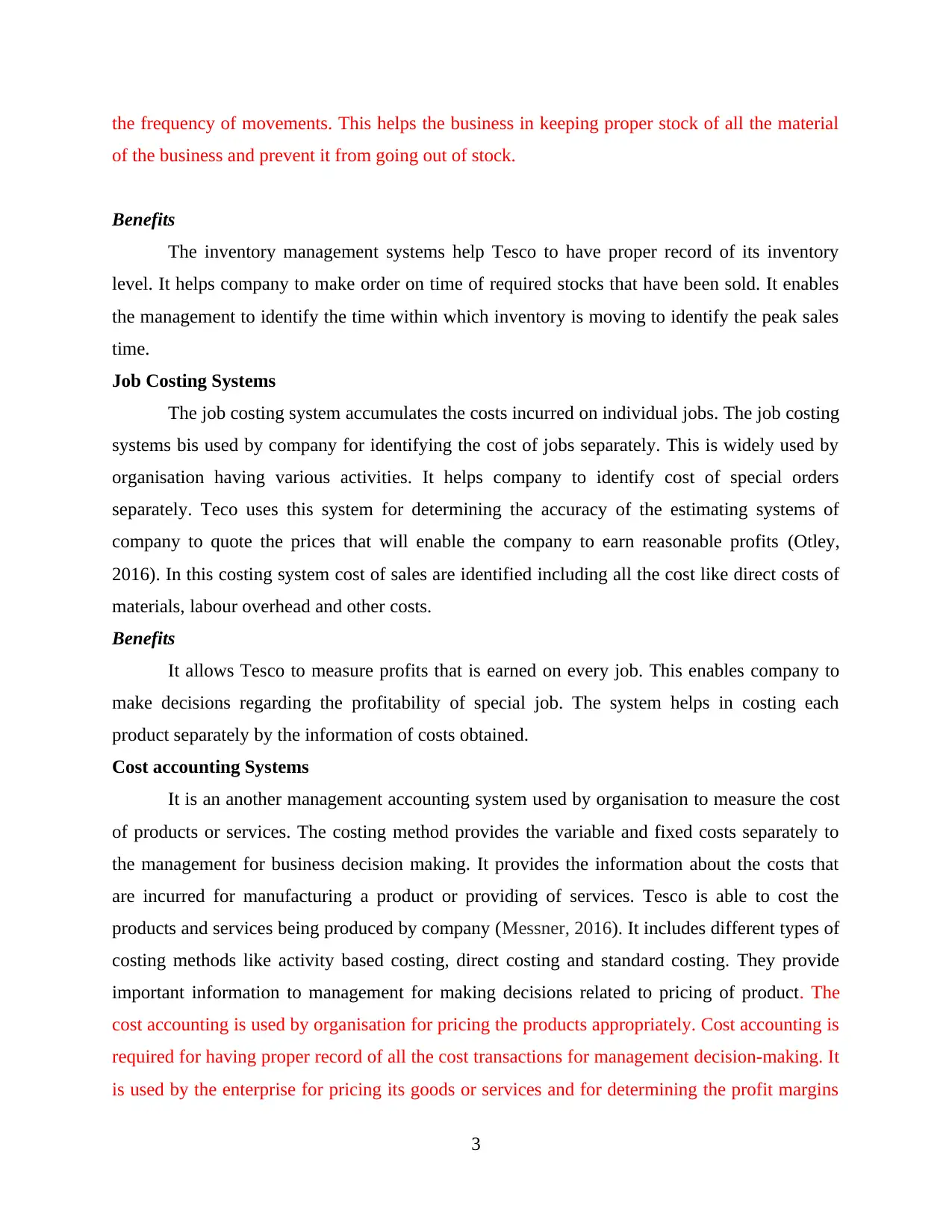
the frequency of movements. This helps the business in keeping proper stock of all the material
of the business and prevent it from going out of stock.
Benefits
The inventory management systems help Tesco to have proper record of its inventory
level. It helps company to make order on time of required stocks that have been sold. It enables
the management to identify the time within which inventory is moving to identify the peak sales
time.
Job Costing Systems
The job costing system accumulates the costs incurred on individual jobs. The job costing
systems bis used by company for identifying the cost of jobs separately. This is widely used by
organisation having various activities. It helps company to identify cost of special orders
separately. Teco uses this system for determining the accuracy of the estimating systems of
company to quote the prices that will enable the company to earn reasonable profits (Otley,
2016). In this costing system cost of sales are identified including all the cost like direct costs of
materials, labour overhead and other costs.
Benefits
It allows Tesco to measure profits that is earned on every job. This enables company to
make decisions regarding the profitability of special job. The system helps in costing each
product separately by the information of costs obtained.
Cost accounting Systems
It is an another management accounting system used by organisation to measure the cost
of products or services. The costing method provides the variable and fixed costs separately to
the management for business decision making. It provides the information about the costs that
are incurred for manufacturing a product or providing of services. Tesco is able to cost the
products and services being produced by company (Messner, 2016). It includes different types of
costing methods like activity based costing, direct costing and standard costing. They provide
important information to management for making decisions related to pricing of product. The
cost accounting is used by organisation for pricing the products appropriately. Cost accounting is
required for having proper record of all the cost transactions for management decision-making. It
is used by the enterprise for pricing its goods or services and for determining the profit margins
3
of the business and prevent it from going out of stock.
Benefits
The inventory management systems help Tesco to have proper record of its inventory
level. It helps company to make order on time of required stocks that have been sold. It enables
the management to identify the time within which inventory is moving to identify the peak sales
time.
Job Costing Systems
The job costing system accumulates the costs incurred on individual jobs. The job costing
systems bis used by company for identifying the cost of jobs separately. This is widely used by
organisation having various activities. It helps company to identify cost of special orders
separately. Teco uses this system for determining the accuracy of the estimating systems of
company to quote the prices that will enable the company to earn reasonable profits (Otley,
2016). In this costing system cost of sales are identified including all the cost like direct costs of
materials, labour overhead and other costs.
Benefits
It allows Tesco to measure profits that is earned on every job. This enables company to
make decisions regarding the profitability of special job. The system helps in costing each
product separately by the information of costs obtained.
Cost accounting Systems
It is an another management accounting system used by organisation to measure the cost
of products or services. The costing method provides the variable and fixed costs separately to
the management for business decision making. It provides the information about the costs that
are incurred for manufacturing a product or providing of services. Tesco is able to cost the
products and services being produced by company (Messner, 2016). It includes different types of
costing methods like activity based costing, direct costing and standard costing. They provide
important information to management for making decisions related to pricing of product. The
cost accounting is used by organisation for pricing the products appropriately. Cost accounting is
required for having proper record of all the cost transactions for management decision-making. It
is used by the enterprise for pricing its goods or services and for determining the profit margins
3
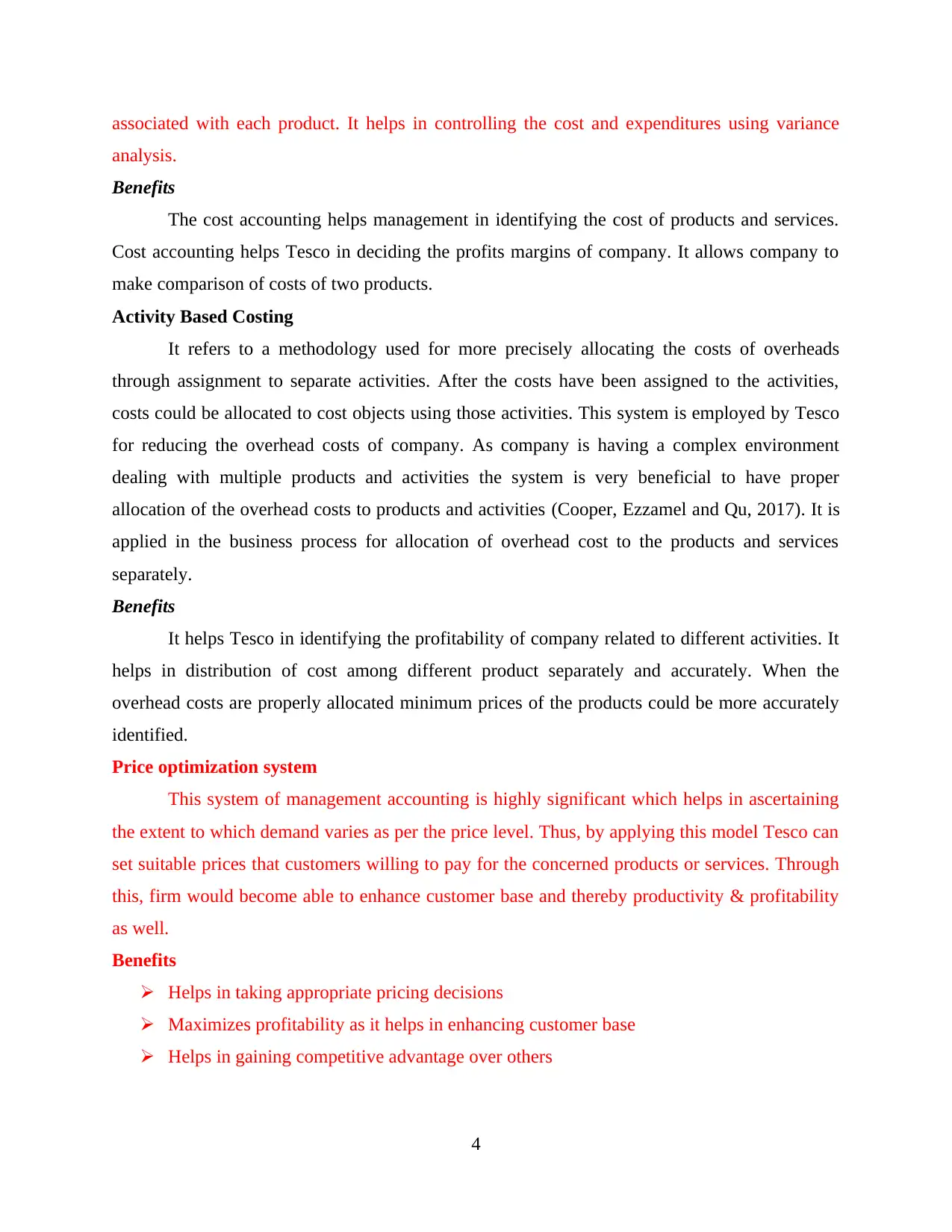
associated with each product. It helps in controlling the cost and expenditures using variance
analysis.
Benefits
The cost accounting helps management in identifying the cost of products and services.
Cost accounting helps Tesco in deciding the profits margins of company. It allows company to
make comparison of costs of two products.
Activity Based Costing
It refers to a methodology used for more precisely allocating the costs of overheads
through assignment to separate activities. After the costs have been assigned to the activities,
costs could be allocated to cost objects using those activities. This system is employed by Tesco
for reducing the overhead costs of company. As company is having a complex environment
dealing with multiple products and activities the system is very beneficial to have proper
allocation of the overhead costs to products and activities (Cooper, Ezzamel and Qu, 2017). It is
applied in the business process for allocation of overhead cost to the products and services
separately.
Benefits
It helps Tesco in identifying the profitability of company related to different activities. It
helps in distribution of cost among different product separately and accurately. When the
overhead costs are properly allocated minimum prices of the products could be more accurately
identified.
Price optimization system
This system of management accounting is highly significant which helps in ascertaining
the extent to which demand varies as per the price level. Thus, by applying this model Tesco can
set suitable prices that customers willing to pay for the concerned products or services. Through
this, firm would become able to enhance customer base and thereby productivity & profitability
as well.
Benefits
Helps in taking appropriate pricing decisions
Maximizes profitability as it helps in enhancing customer base
Helps in gaining competitive advantage over others
4
analysis.
Benefits
The cost accounting helps management in identifying the cost of products and services.
Cost accounting helps Tesco in deciding the profits margins of company. It allows company to
make comparison of costs of two products.
Activity Based Costing
It refers to a methodology used for more precisely allocating the costs of overheads
through assignment to separate activities. After the costs have been assigned to the activities,
costs could be allocated to cost objects using those activities. This system is employed by Tesco
for reducing the overhead costs of company. As company is having a complex environment
dealing with multiple products and activities the system is very beneficial to have proper
allocation of the overhead costs to products and activities (Cooper, Ezzamel and Qu, 2017). It is
applied in the business process for allocation of overhead cost to the products and services
separately.
Benefits
It helps Tesco in identifying the profitability of company related to different activities. It
helps in distribution of cost among different product separately and accurately. When the
overhead costs are properly allocated minimum prices of the products could be more accurately
identified.
Price optimization system
This system of management accounting is highly significant which helps in ascertaining
the extent to which demand varies as per the price level. Thus, by applying this model Tesco can
set suitable prices that customers willing to pay for the concerned products or services. Through
this, firm would become able to enhance customer base and thereby productivity & profitability
as well.
Benefits
Helps in taking appropriate pricing decisions
Maximizes profitability as it helps in enhancing customer base
Helps in gaining competitive advantage over others
4
⊘ This is a preview!⊘
Do you want full access?
Subscribe today to unlock all pages.

Trusted by 1+ million students worldwide
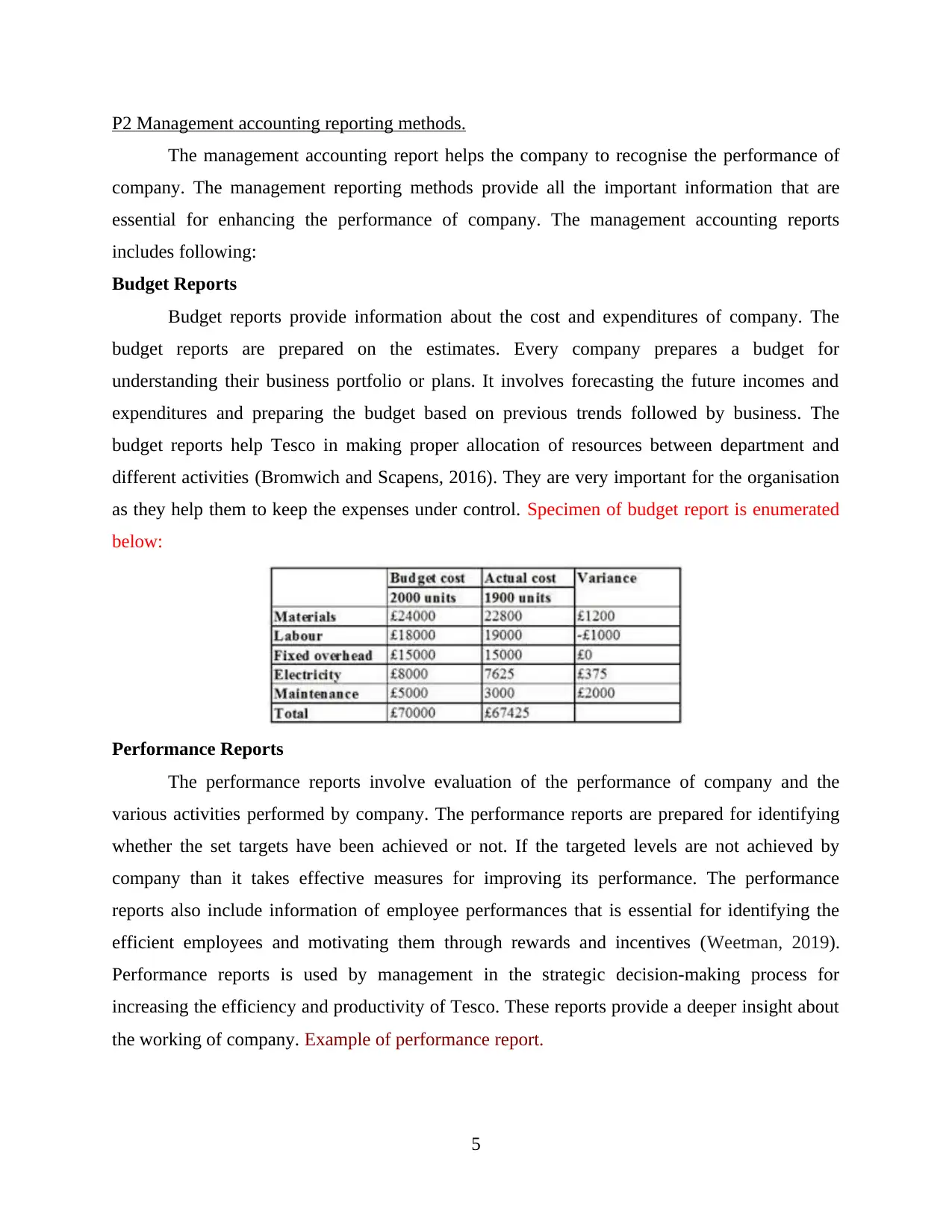
P2 Management accounting reporting methods.
The management accounting report helps the company to recognise the performance of
company. The management reporting methods provide all the important information that are
essential for enhancing the performance of company. The management accounting reports
includes following:
Budget Reports
Budget reports provide information about the cost and expenditures of company. The
budget reports are prepared on the estimates. Every company prepares a budget for
understanding their business portfolio or plans. It involves forecasting the future incomes and
expenditures and preparing the budget based on previous trends followed by business. The
budget reports help Tesco in making proper allocation of resources between department and
different activities (Bromwich and Scapens, 2016). They are very important for the organisation
as they help them to keep the expenses under control. Specimen of budget report is enumerated
below:
Performance Reports
The performance reports involve evaluation of the performance of company and the
various activities performed by company. The performance reports are prepared for identifying
whether the set targets have been achieved or not. If the targeted levels are not achieved by
company than it takes effective measures for improving its performance. The performance
reports also include information of employee performances that is essential for identifying the
efficient employees and motivating them through rewards and incentives (Weetman, 2019).
Performance reports is used by management in the strategic decision-making process for
increasing the efficiency and productivity of Tesco. These reports provide a deeper insight about
the working of company. Example of performance report.
5
The management accounting report helps the company to recognise the performance of
company. The management reporting methods provide all the important information that are
essential for enhancing the performance of company. The management accounting reports
includes following:
Budget Reports
Budget reports provide information about the cost and expenditures of company. The
budget reports are prepared on the estimates. Every company prepares a budget for
understanding their business portfolio or plans. It involves forecasting the future incomes and
expenditures and preparing the budget based on previous trends followed by business. The
budget reports help Tesco in making proper allocation of resources between department and
different activities (Bromwich and Scapens, 2016). They are very important for the organisation
as they help them to keep the expenses under control. Specimen of budget report is enumerated
below:
Performance Reports
The performance reports involve evaluation of the performance of company and the
various activities performed by company. The performance reports are prepared for identifying
whether the set targets have been achieved or not. If the targeted levels are not achieved by
company than it takes effective measures for improving its performance. The performance
reports also include information of employee performances that is essential for identifying the
efficient employees and motivating them through rewards and incentives (Weetman, 2019).
Performance reports is used by management in the strategic decision-making process for
increasing the efficiency and productivity of Tesco. These reports provide a deeper insight about
the working of company. Example of performance report.
5
Paraphrase This Document
Need a fresh take? Get an instant paraphrase of this document with our AI Paraphraser
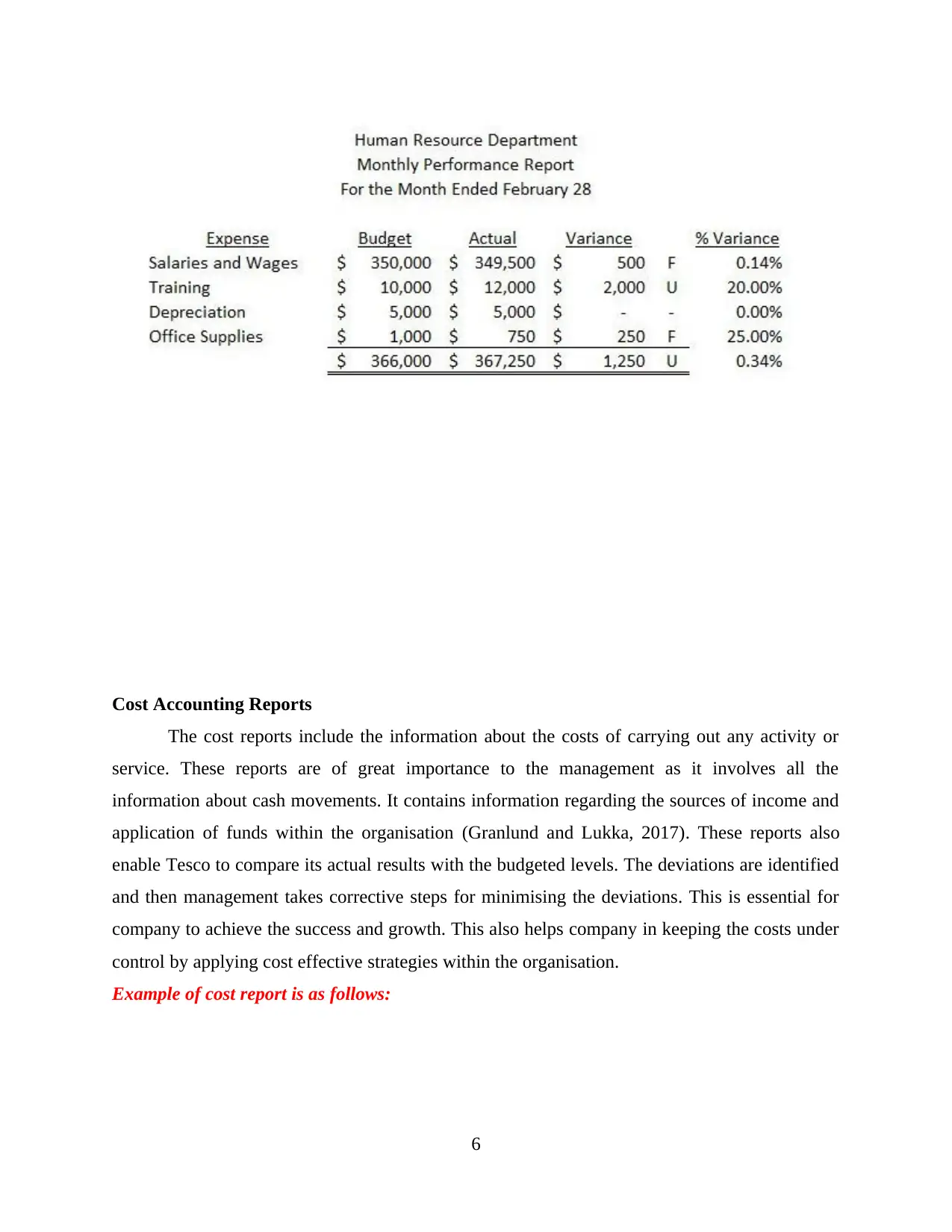
Cost Accounting Reports
The cost reports include the information about the costs of carrying out any activity or
service. These reports are of great importance to the management as it involves all the
information about cash movements. It contains information regarding the sources of income and
application of funds within the organisation (Granlund and Lukka, 2017). These reports also
enable Tesco to compare its actual results with the budgeted levels. The deviations are identified
and then management takes corrective steps for minimising the deviations. This is essential for
company to achieve the success and growth. This also helps company in keeping the costs under
control by applying cost effective strategies within the organisation.
Example of cost report is as follows:
6
The cost reports include the information about the costs of carrying out any activity or
service. These reports are of great importance to the management as it involves all the
information about cash movements. It contains information regarding the sources of income and
application of funds within the organisation (Granlund and Lukka, 2017). These reports also
enable Tesco to compare its actual results with the budgeted levels. The deviations are identified
and then management takes corrective steps for minimising the deviations. This is essential for
company to achieve the success and growth. This also helps company in keeping the costs under
control by applying cost effective strategies within the organisation.
Example of cost report is as follows:
6
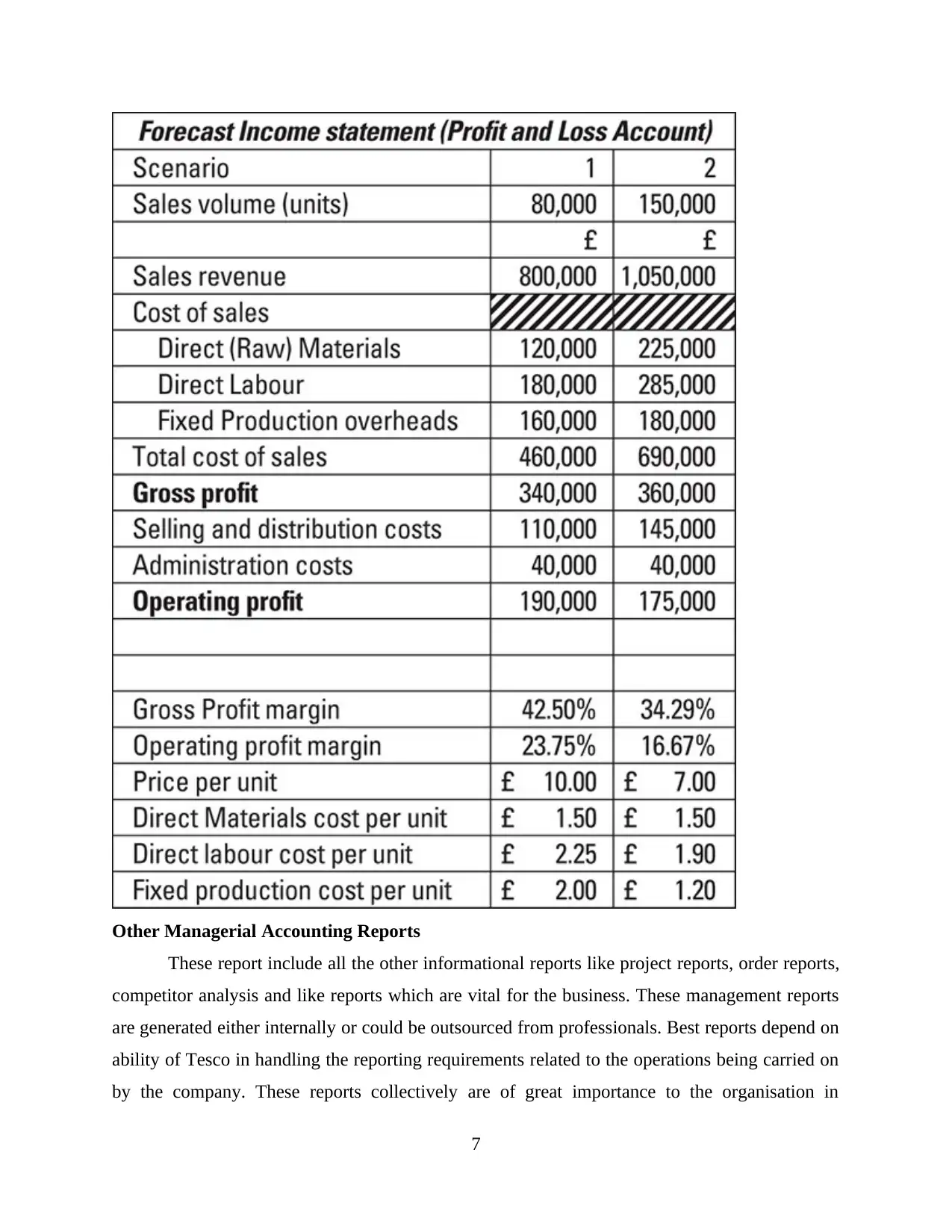
Other Managerial Accounting Reports
These report include all the other informational reports like project reports, order reports,
competitor analysis and like reports which are vital for the business. These management reports
are generated either internally or could be outsourced from professionals. Best reports depend on
ability of Tesco in handling the reporting requirements related to the operations being carried on
by the company. These reports collectively are of great importance to the organisation in
7
These report include all the other informational reports like project reports, order reports,
competitor analysis and like reports which are vital for the business. These management reports
are generated either internally or could be outsourced from professionals. Best reports depend on
ability of Tesco in handling the reporting requirements related to the operations being carried on
by the company. These reports collectively are of great importance to the organisation in
7
⊘ This is a preview!⊘
Do you want full access?
Subscribe today to unlock all pages.

Trusted by 1+ million students worldwide
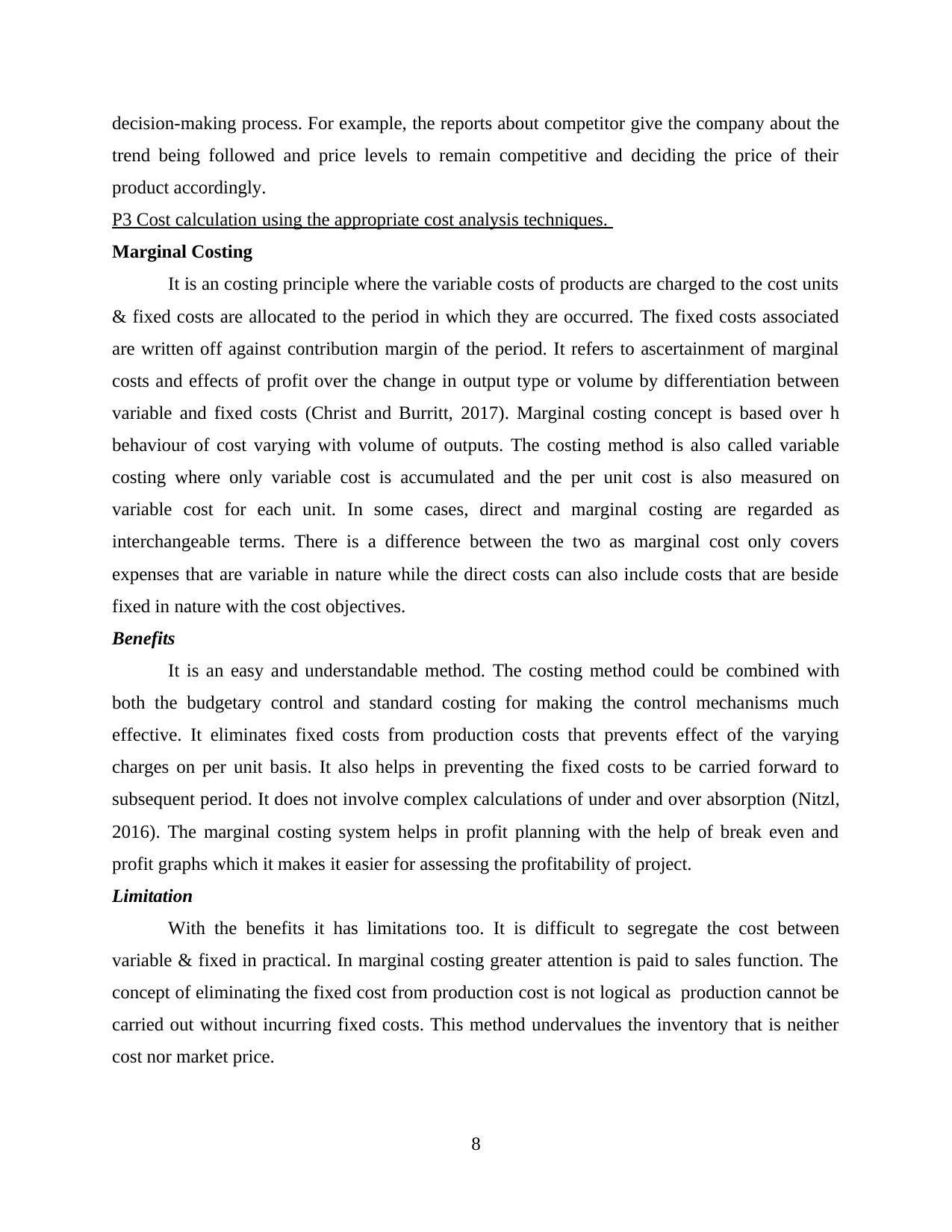
decision-making process. For example, the reports about competitor give the company about the
trend being followed and price levels to remain competitive and deciding the price of their
product accordingly.
P3 Cost calculation using the appropriate cost analysis techniques.
Marginal Costing
It is an costing principle where the variable costs of products are charged to the cost units
& fixed costs are allocated to the period in which they are occurred. The fixed costs associated
are written off against contribution margin of the period. It refers to ascertainment of marginal
costs and effects of profit over the change in output type or volume by differentiation between
variable and fixed costs (Christ and Burritt, 2017). Marginal costing concept is based over h
behaviour of cost varying with volume of outputs. The costing method is also called variable
costing where only variable cost is accumulated and the per unit cost is also measured on
variable cost for each unit. In some cases, direct and marginal costing are regarded as
interchangeable terms. There is a difference between the two as marginal cost only covers
expenses that are variable in nature while the direct costs can also include costs that are beside
fixed in nature with the cost objectives.
Benefits
It is an easy and understandable method. The costing method could be combined with
both the budgetary control and standard costing for making the control mechanisms much
effective. It eliminates fixed costs from production costs that prevents effect of the varying
charges on per unit basis. It also helps in preventing the fixed costs to be carried forward to
subsequent period. It does not involve complex calculations of under and over absorption (Nitzl,
2016). The marginal costing system helps in profit planning with the help of break even and
profit graphs which it makes it easier for assessing the profitability of project.
Limitation
With the benefits it has limitations too. It is difficult to segregate the cost between
variable & fixed in practical. In marginal costing greater attention is paid to sales function. The
concept of eliminating the fixed cost from production cost is not logical as production cannot be
carried out without incurring fixed costs. This method undervalues the inventory that is neither
cost nor market price.
8
trend being followed and price levels to remain competitive and deciding the price of their
product accordingly.
P3 Cost calculation using the appropriate cost analysis techniques.
Marginal Costing
It is an costing principle where the variable costs of products are charged to the cost units
& fixed costs are allocated to the period in which they are occurred. The fixed costs associated
are written off against contribution margin of the period. It refers to ascertainment of marginal
costs and effects of profit over the change in output type or volume by differentiation between
variable and fixed costs (Christ and Burritt, 2017). Marginal costing concept is based over h
behaviour of cost varying with volume of outputs. The costing method is also called variable
costing where only variable cost is accumulated and the per unit cost is also measured on
variable cost for each unit. In some cases, direct and marginal costing are regarded as
interchangeable terms. There is a difference between the two as marginal cost only covers
expenses that are variable in nature while the direct costs can also include costs that are beside
fixed in nature with the cost objectives.
Benefits
It is an easy and understandable method. The costing method could be combined with
both the budgetary control and standard costing for making the control mechanisms much
effective. It eliminates fixed costs from production costs that prevents effect of the varying
charges on per unit basis. It also helps in preventing the fixed costs to be carried forward to
subsequent period. It does not involve complex calculations of under and over absorption (Nitzl,
2016). The marginal costing system helps in profit planning with the help of break even and
profit graphs which it makes it easier for assessing the profitability of project.
Limitation
With the benefits it has limitations too. It is difficult to segregate the cost between
variable & fixed in practical. In marginal costing greater attention is paid to sales function. The
concept of eliminating the fixed cost from production cost is not logical as production cannot be
carried out without incurring fixed costs. This method undervalues the inventory that is neither
cost nor market price.
8
Paraphrase This Document
Need a fresh take? Get an instant paraphrase of this document with our AI Paraphraser
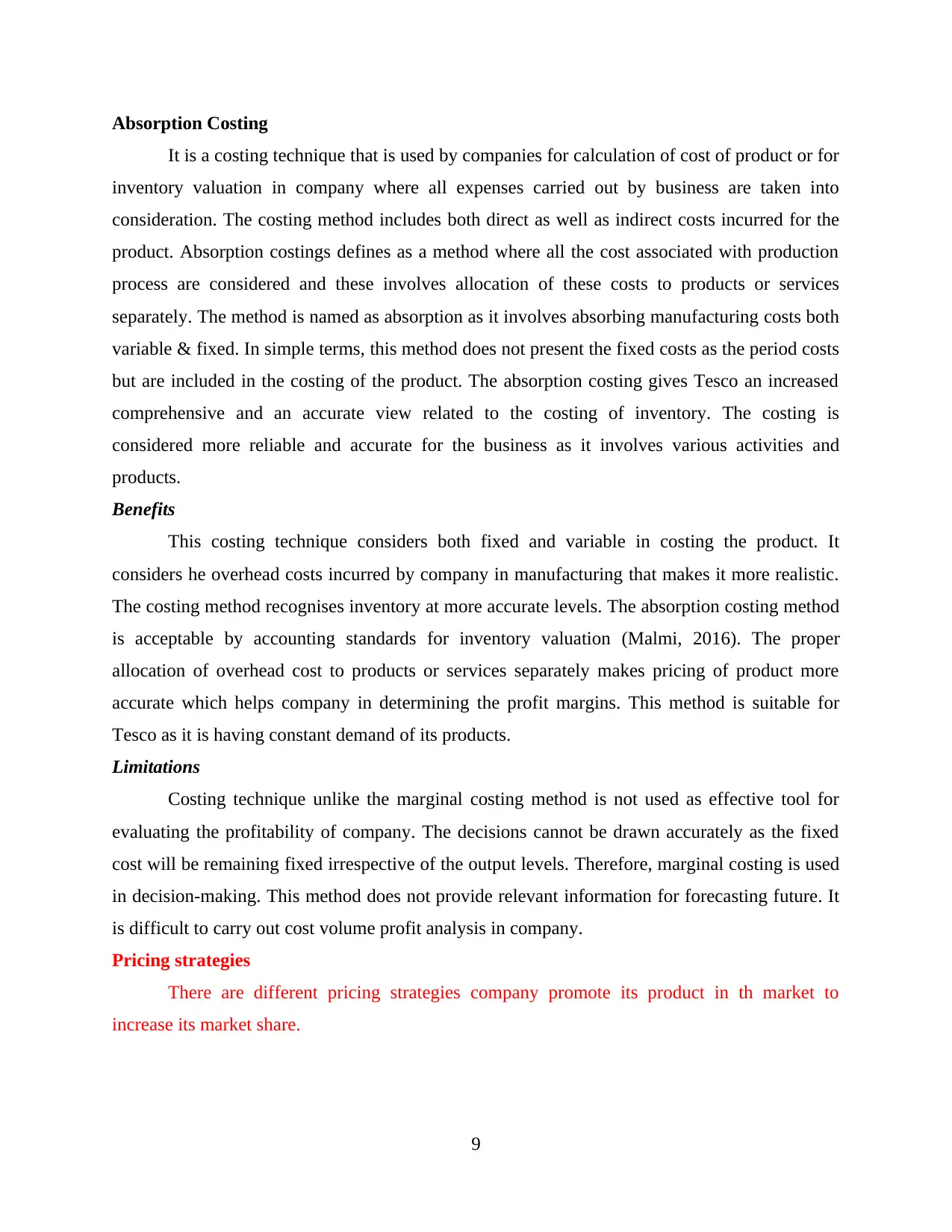
Absorption Costing
It is a costing technique that is used by companies for calculation of cost of product or for
inventory valuation in company where all expenses carried out by business are taken into
consideration. The costing method includes both direct as well as indirect costs incurred for the
product. Absorption costings defines as a method where all the cost associated with production
process are considered and these involves allocation of these costs to products or services
separately. The method is named as absorption as it involves absorbing manufacturing costs both
variable & fixed. In simple terms, this method does not present the fixed costs as the period costs
but are included in the costing of the product. The absorption costing gives Tesco an increased
comprehensive and an accurate view related to the costing of inventory. The costing is
considered more reliable and accurate for the business as it involves various activities and
products.
Benefits
This costing technique considers both fixed and variable in costing the product. It
considers he overhead costs incurred by company in manufacturing that makes it more realistic.
The costing method recognises inventory at more accurate levels. The absorption costing method
is acceptable by accounting standards for inventory valuation (Malmi, 2016). The proper
allocation of overhead cost to products or services separately makes pricing of product more
accurate which helps company in determining the profit margins. This method is suitable for
Tesco as it is having constant demand of its products.
Limitations
Costing technique unlike the marginal costing method is not used as effective tool for
evaluating the profitability of company. The decisions cannot be drawn accurately as the fixed
cost will be remaining fixed irrespective of the output levels. Therefore, marginal costing is used
in decision-making. This method does not provide relevant information for forecasting future. It
is difficult to carry out cost volume profit analysis in company.
Pricing strategies
There are different pricing strategies company promote its product in th market to
increase its market share.
9
It is a costing technique that is used by companies for calculation of cost of product or for
inventory valuation in company where all expenses carried out by business are taken into
consideration. The costing method includes both direct as well as indirect costs incurred for the
product. Absorption costings defines as a method where all the cost associated with production
process are considered and these involves allocation of these costs to products or services
separately. The method is named as absorption as it involves absorbing manufacturing costs both
variable & fixed. In simple terms, this method does not present the fixed costs as the period costs
but are included in the costing of the product. The absorption costing gives Tesco an increased
comprehensive and an accurate view related to the costing of inventory. The costing is
considered more reliable and accurate for the business as it involves various activities and
products.
Benefits
This costing technique considers both fixed and variable in costing the product. It
considers he overhead costs incurred by company in manufacturing that makes it more realistic.
The costing method recognises inventory at more accurate levels. The absorption costing method
is acceptable by accounting standards for inventory valuation (Malmi, 2016). The proper
allocation of overhead cost to products or services separately makes pricing of product more
accurate which helps company in determining the profit margins. This method is suitable for
Tesco as it is having constant demand of its products.
Limitations
Costing technique unlike the marginal costing method is not used as effective tool for
evaluating the profitability of company. The decisions cannot be drawn accurately as the fixed
cost will be remaining fixed irrespective of the output levels. Therefore, marginal costing is used
in decision-making. This method does not provide relevant information for forecasting future. It
is difficult to carry out cost volume profit analysis in company.
Pricing strategies
There are different pricing strategies company promote its product in th market to
increase its market share.
9
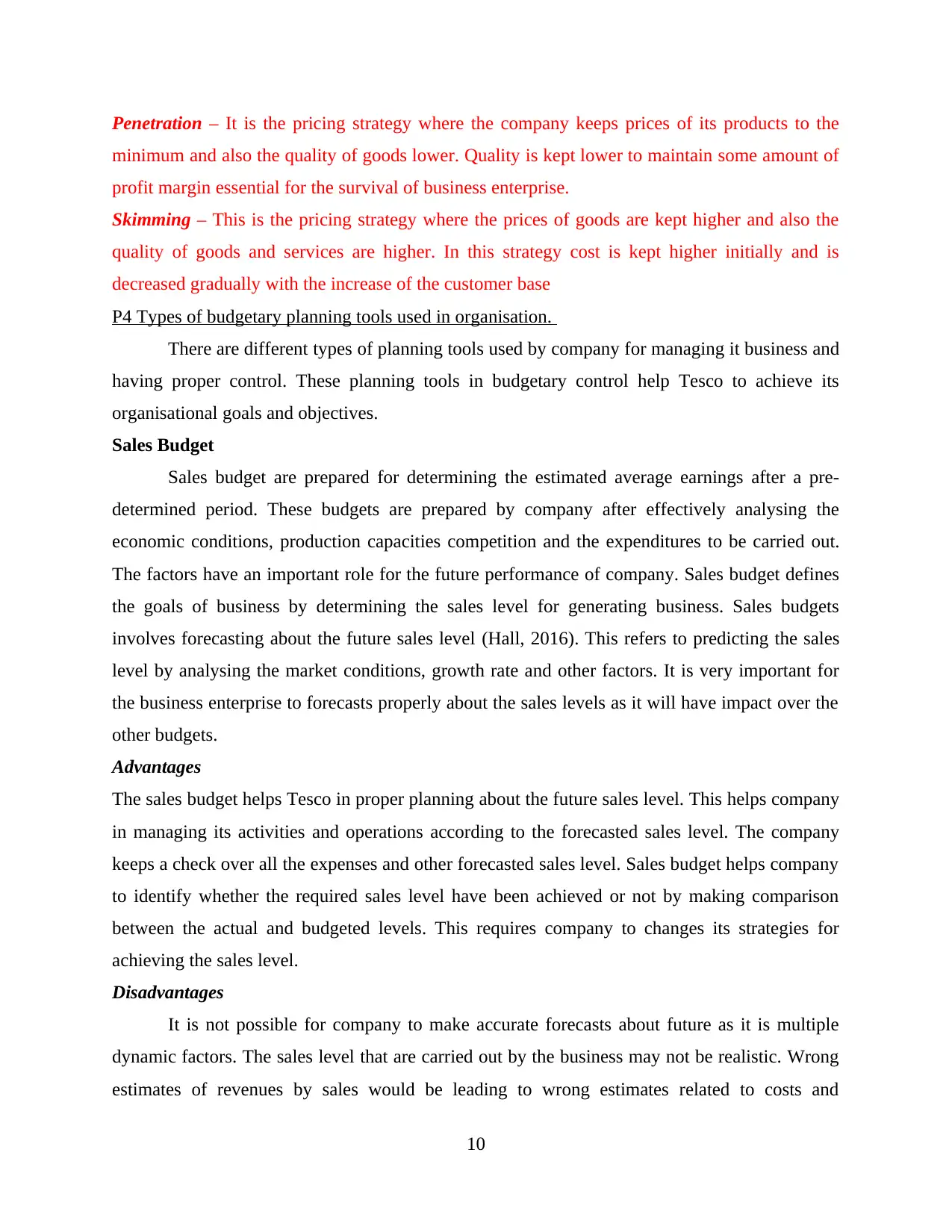
Penetration – It is the pricing strategy where the company keeps prices of its products to the
minimum and also the quality of goods lower. Quality is kept lower to maintain some amount of
profit margin essential for the survival of business enterprise.
Skimming – This is the pricing strategy where the prices of goods are kept higher and also the
quality of goods and services are higher. In this strategy cost is kept higher initially and is
decreased gradually with the increase of the customer base
P4 Types of budgetary planning tools used in organisation.
There are different types of planning tools used by company for managing it business and
having proper control. These planning tools in budgetary control help Tesco to achieve its
organisational goals and objectives.
Sales Budget
Sales budget are prepared for determining the estimated average earnings after a pre-
determined period. These budgets are prepared by company after effectively analysing the
economic conditions, production capacities competition and the expenditures to be carried out.
The factors have an important role for the future performance of company. Sales budget defines
the goals of business by determining the sales level for generating business. Sales budgets
involves forecasting about the future sales level (Hall, 2016). This refers to predicting the sales
level by analysing the market conditions, growth rate and other factors. It is very important for
the business enterprise to forecasts properly about the sales levels as it will have impact over the
other budgets.
Advantages
The sales budget helps Tesco in proper planning about the future sales level. This helps company
in managing its activities and operations according to the forecasted sales level. The company
keeps a check over all the expenses and other forecasted sales level. Sales budget helps company
to identify whether the required sales level have been achieved or not by making comparison
between the actual and budgeted levels. This requires company to changes its strategies for
achieving the sales level.
Disadvantages
It is not possible for company to make accurate forecasts about future as it is multiple
dynamic factors. The sales level that are carried out by the business may not be realistic. Wrong
estimates of revenues by sales would be leading to wrong estimates related to costs and
10
minimum and also the quality of goods lower. Quality is kept lower to maintain some amount of
profit margin essential for the survival of business enterprise.
Skimming – This is the pricing strategy where the prices of goods are kept higher and also the
quality of goods and services are higher. In this strategy cost is kept higher initially and is
decreased gradually with the increase of the customer base
P4 Types of budgetary planning tools used in organisation.
There are different types of planning tools used by company for managing it business and
having proper control. These planning tools in budgetary control help Tesco to achieve its
organisational goals and objectives.
Sales Budget
Sales budget are prepared for determining the estimated average earnings after a pre-
determined period. These budgets are prepared by company after effectively analysing the
economic conditions, production capacities competition and the expenditures to be carried out.
The factors have an important role for the future performance of company. Sales budget defines
the goals of business by determining the sales level for generating business. Sales budgets
involves forecasting about the future sales level (Hall, 2016). This refers to predicting the sales
level by analysing the market conditions, growth rate and other factors. It is very important for
the business enterprise to forecasts properly about the sales levels as it will have impact over the
other budgets.
Advantages
The sales budget helps Tesco in proper planning about the future sales level. This helps company
in managing its activities and operations according to the forecasted sales level. The company
keeps a check over all the expenses and other forecasted sales level. Sales budget helps company
to identify whether the required sales level have been achieved or not by making comparison
between the actual and budgeted levels. This requires company to changes its strategies for
achieving the sales level.
Disadvantages
It is not possible for company to make accurate forecasts about future as it is multiple
dynamic factors. The sales level that are carried out by the business may not be realistic. Wrong
estimates of revenues by sales would be leading to wrong estimates related to costs and
10
⊘ This is a preview!⊘
Do you want full access?
Subscribe today to unlock all pages.

Trusted by 1+ million students worldwide
1 out of 17
Related Documents
Your All-in-One AI-Powered Toolkit for Academic Success.
+13062052269
info@desklib.com
Available 24*7 on WhatsApp / Email
![[object Object]](/_next/static/media/star-bottom.7253800d.svg)
Unlock your academic potential
Copyright © 2020–2025 A2Z Services. All Rights Reserved. Developed and managed by ZUCOL.





